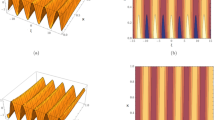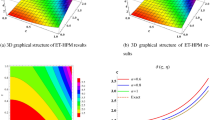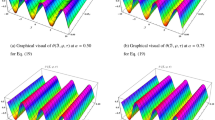Abstract
In this paper, Mohand homotopy transform scheme is introduced to obtain the numerical solution of fractional Kundu–Eckhaus and coupled fractional Massive Thirring equations. The massive Thirring model consists of a system of two nonlinear complex differential equations, and it plays a dynamic role in quantum field theory. We combine Mohand transform with homotopy perturbation scheme and show the results in the form of easy convergence. The accuracy of the scheme is considerably increased by deriving numerical results in the form of a quick converge series. Some graphical plot distributions are presented to show that the present approach is very simple and straightforward.
Similar content being viewed by others
Introduction
Fractional calculus (FC) has grown importance in recent years and is now widely used in a variety of disciplines, such as ecology, physics, astronomy, and economics. After the concepts of FC to a variety of various features, scientists are starting to realise that the fractional framework may be compatible with a wide range of phenomena in common applied sciences. Fractional differential equations are used in the development of mathematical models for a variety of physical processes such as, in physics, dynamical systems, power systems, and applied science1,2. Kundu and Eckhaus3,4 introduced the fractional Kundu–Eckhaus equation such as,
This equation appears in quantum field theory and and other dispersion fields. It is also a combination of Lax couples, higher conserved portion, particular soliton solution and rogue wave solution. The development of a scientific design that supports ultra-short light pulses in a glass fibre is crucial. The development of a scientific design that supports ultra-short light pulses in a glass fibre is crucial. The fractional Massive Thirring problem
was autonomously introduced 1958 by Thirring. It is a nonlinear coupled fractional differential equation which appears in the quantum field theory5. The Kundu equation and the derivative Schrodinger equation’s explicit particular single solutions were obtained using the algebraic curve approach6. Yi and Liu7 used the bifurcation scheme to extend the traveling wave solutions for the Kundu equation. Recently, some authors8,9 have investigated the numerous characteristics of this equation, its generalisations, and its connections to other nonlinear equations. Various exact travelling wave solutions for the Kundu equation with fifth-order nonlinear term are obtained in10. It is categorised as a variant of several well-known integrable equations, including the nonlinear Schrodinger equation and several other nonlinear equations, via a gauge transformation.
Many researchers have studied the analytical solution of differential problems through various approaches such as, gauge transformation11, Lie symmetry method12, Bernoulli subequation method13, Residual power series method14, Runge-Kutta method15, B\(\ddot{a}\)cklund transformation16, Spectral collocation method17, Natural transform18, Sine-Gordon expansion approach19 and Darboux transformation20 and rogue wave solutions21. Anjum and Ain22 used He’s fractional derivative for the time fractional Camassa-Holm equation. Gepreel and Mohamed23 implemented homotopy analysis scheme for the approximate solution of nonlinear space-time fractional derivatives Klein-Gordon equation. Many scientists developed a variety of semi-analytical and numerical techniques to investigate fractional derivatives and fractional differential equations. He24 developed a scheme known as HPS that does not depend upon a small parameter to estimate the approximate solution of a nonlinear model. Later, Nadeem and Li25 combined HPS with Laplace transform to find the approximate solution of nonlinear vibration systems and nonlinear wave equations. It is clear that HPS is a potent technique and successful for nonlinear problems26. Although it can be difficult to find analytical solutions for the majority of issues, semi-analytical approaches can still be used to address these issues.
In this study, we present a method based on the formulation of the Mohand transform with HPS to investigate the approximation of the solutions of the fractional Massive Thirring and coupled fractional Kundu–Eckhaus equations. The resulting series provide us the results relatively quickly, and we see that the computational series only reaches the precise solution after a limited number of iterations. We design this study such as: In “Basic idea of HPS” section, a brief idea of HPS for a nonlinear problem has been explained. Some basic definitions of Mohand transform and the development of Mohand transform with HPS are defined in “Concept of Mohand transform” and “Development of Mohand transform with HPS” sections respectively. Two numerical applications are provided to check the authenticity of our proposed scheme and also show it with some graphical illustrations in “Numerical application” section. Conclusion is discussed in the last “Conclusion” section.
Basic idea of HPS
Consider the following nonlinear problem to present the concept of HPS25,
with boundary conditions
where \(T_{1}\) is particular operators, \(T_{2}\) is a boundary operator, h(q) is a known function, and \(\Gamma \) is the boundary of the ___domain \(\Omega \). We can divide operator \(T_{1}\) into into two parts, \(S_{1}\) and \(S_{2}\) with considering linear and nonlinear operators respectively. Thus, Eq. (3) may also be stated as
Let us develop a homotopy \(\rho (q,p):\Omega \times [0,1]\rightarrow {\mathbb {R}}\) which satisfies
or
where \(p\in [0,1]\), is termed as homotopy parameter, and \(\psi _{0}\) is an initial guess of Eq. (4) that complies with the boundary conditions. Since the definition of HPS states that p is estimated as a small parameter, so, we may consider the solution of Eq. (3) in terms of a power series of p such as,
Choosing \(p=1\), the estimated solution of Eq. (7) is acquired as,
The nonlinear terms are evaluated as
where polynomials \(H_{n}(\psi )\) are presented such as
Since the series depends on the nonlinear operator S. Therefore, the results obtained in Eq. (7) are convergent.
Concept of Mohand transform
In this section, we go over several basic Mohand transform properties and ideas that are essential for formulating this strategy.
Definition 3.1
Mohand transform for a function \(\psi (\varphi )\) is defined as27
Conversely, if R(r) is the MT of \(\psi (\varphi )\), then \(\psi (\varphi )\) is called the inverse of R(r) i.e.,
here \(M^{-1}\) is known as inverse MT.
Definition 3.2
Mohand transform of fractional derivative is expressed as28
Definition 3.3
Some properties of MT are defined as,
- (a):
-
\(M\{\psi '(\varphi )\}=rR(r)-r^{2}R(0)\).
- (b):
-
\(M\{\psi ''(\varphi )\}=r^{2}R(r)-r^{3}R(0)-r^{2}R'(0)\).
- (c):
-
\(M\{\psi ^{n}(\varphi )\}=r^{n}R(r)-r^{n+1}R(0)-r^{n}R'(0)-\cdots -r^{n}R^{n-1}(0)\).
Development of Mohand transform with HPS
This segment explains the development of the Mohand transform with HPS to obtain the approximate solution of fractional Kundu–Eckhaus and coupled fractional Massive Thirring equations. We consider the differential equation such as
where \(D^{\alpha }_{\varphi }=\dfrac{\partial ^{\alpha }}{\partial \varphi ^{\alpha }}\) express the fractional order \(\alpha \) of \(\psi (\varphi )\). Employing MT on Eq. (9)
When we use the MT definition, we get
on solving, we obtain
Using Eq. (10), it yields
Applying inverse MT, we get the recurrence relation of \(\psi (\rho ,\varphi )\) such as
where
Let us assume the approximate solution of Eq. (9) as follows
and
where \(p\in [0,1]\), is embedding parameter whereas \(\psi _{0}(\rho , \varphi )\) is an initial guess of Eq. (9). We can use the following formula to get the polynomials
Combining the Eqs. (13) and (14), (12) can be written as
When we analyze the related parts of p, we obtain
Therefore, we can combine Eq. (15) such as
If \(p=1\), then Eq. (16) yields
We propose this approach in light of upcoming mathematical applications.
Numerical application
In this section, we apply the formulation of a new strategy to the numerical applications and demonstrate that this strategy is very convenient and suitable. Results are obtained in the form of a series. Graphical findings demonstrate that the approximate solution converges to the exact solution within a small number of iterations.
Example 1
We may rewrite the Eq. (1) such as
with the following initial conditions
we may rewrite Eq. (17) as follow
where \(\mid \psi \mid ^{2}=\psi {\bar{\psi }}\) and \({\bar{\psi }}\) is the conjugate of \(\psi \).
Taking Mohand transform on both sides of Eq. (19), we get
Using the properties of the transformation on Eq. (20), we get
On solving, we get
Taking inverse Mohamd transform, we get
Equating the identical powers of p of Eq. (21), we get, we get
hence, the derived results are obtained as follows,
on continuing this process, we can achieve the following series,
which can be in closed form of29,30 at \(\alpha = 1\)
Surfaces solution of Eq. (10) when \(\alpha =1\).
We divide Fig. 1 into two parts (a) the real part of the surface solution and (b) the imaginary part of the surface solution at \(-5\le \rho \le 5\) and \(0\le \varphi \le 5\) with \(\alpha =1\). Figure 2 provided in (a) Real part of plot distribution (b) Imaginary part of plot distribution for \(\alpha =0.25, 0.5, 0.75, 1\) at \(\varphi =1\).
Example 2
We may rewrite the Eq. (2) such as
with the following initial conditions
Let Eq. (24) yields
where \(\mid \psi \mid ^{2}=\psi {\bar{\psi }}\), \(\mid \phi \mid ^{2}=\phi {\bar{\phi }}\) with \({\bar{\psi }}\) and \({\bar{\phi }}\) are the conjugate of \(\psi \) and \(\phi \) respectively. Taking Mohand transform on both sides of Eq. (26), we get
Using the properties of the transformation on Eq. (27), we get
On solving, we get
Taking inverse Mohand transform, we obtain
Equating the identical powers of p from system of Eq. (28), we get
at \(p=1\), we get
at \(p=2\), we get
hence, the derived results are obtained as follows,
at \(p=1\), we get
at \(p=2\), we get
on continuing this process, we can achieve the following series
By solving the above equations, and using the approximate solution
Surfaces solution of Eq. (29) when \(\alpha =1\).
Figure 3 has been divided into two parts: (a) Real part of \(\psi \) and \(\phi \) (b) Imaginary part of \(\psi \) and \(\phi \) at \(-2\le \rho \le 2\) and \(0\le \varphi \le 2\) with \(\alpha =1\) and Fig. 4 provided in (a) Real part of plot distribution for \(\psi \) and \(\phi \) (b) Imaginary part of plot distribution for \(\psi \) and \(\phi \) for \(\alpha =0.25, 0.5, 0.75, 1\) at \(\varphi =1\).
Conclusion
In the current paper, we have successfully applied a new strategy where Mohand transform is combined with homotopy perturbation scheme to obtain the approximate solution of the fractional Kundu–Eckhaus and coupled fractional Massive Thirring equations. This approach is capable to handle the fractional problems without involving any small assumption or perturbation study. The results reveal that this strategy has a high accuracy rate and handles quickly without any discretization. We use Mathematica 11 to sketch the plot distribution. Our results show that this approach has an excellent performance in finding the analytical solution of fractional Kundu–Eckhaus and coupled fractional Massive Thirring equations. In the future, we believe that this strategy is suitable and feasible for other fractional differential problems arising in science and engineering.
Data availability
We have provided all the data within the article.
References
Sabir, Z., Raja, M. A. Z. & Baleanu, D. Fractional Mayer neuro-swarm heuristic solver for multi-fractional order doubly singular model based on Lane–Emden equation. Fractals 29(05), 2140017 (2021).
Habib, S., Islam, A., Batool, A., Sohail, M. U. & Nadeem, M. Numerical solutions of the fractal foam drainage equation. GEM-Int. J. Geomath. 12, 1–10 (2021).
Kundu, A. Landau–Lifshitz and higher-order nonlinear systems gauge generated from nonlinear schrödinger-type equations. J. Math. Phys. 25(12), 3433–3438 (1984).
Eckhaus, W. The long-time behaviour for perturbed wave-equations and related problems. In Trends in Applications of Pure Mathematics to Mechanics 168–194 (Springer, 1986).
Korepin, V. E. Direct calculation of the s matrix in the massive thirring model. Teoreticheskaya i Matematicheskaya Fizika 41(2), 169–189 (1979).
Feng, Z. & Wang, X. Explicit exact solitary wave solutions for the Kundu equation and the derivative schrödinger equation. Phys. Scr. 64(1), 7 (2001).
Yi, Y. & Liu, Z. The bifurcations of traveling wave solutions of the Kundu equation. J. Appl. Math. 2013 (2013) Article ID 137475.
Zhang, W., Qin, Y., Zhao, Y. & Guo, B. Orbital stability of solitary waves for Kundu equation. J. Differ. Equ. 247(5), 1591–1615 (2009).
Liu, C., Liu, J., Zhou, P. & Chen, M. Exact solutions with bounded periodic amplitude for Kundu equation and derivative nonlinear schrödinger equation. J. Adv. Math. Comput. Sci. 16(5), 1–6 (2016).
Zhang, H. Various exact travelling wave solutions for Kundu equation with fifth-order nonlinear term. Rep. Math. Phys. 65(2), 231–239 (2010).
Kundu, A. Exact solutions to higher-order nonlinear equations through gauge transformation. Phys. D Nonlinear Phenom. 25(1–3), 399–406 (1987).
Toomanian, M. & Asadi, N. Reductions for Kundu–Eckhaus equation via lie symmetry analysis. Math. Sci. 7(1), 50 (2013).
Baskonus, H. M. & Bulut, H. On the complex structures of Kundu–Eckhaus equation via improved Bernoulli sub-equation function method. Waves Random Complex Media 25(4), 720–728 (2015).
Al-Smadi, M., Arqub, O. A. & Hadid, S. Approximate solutions of nonlinear fractional Kundu–Eckhaus and coupled fractional massive thirring equations emerging in quantum field theory using conformable residual power series method. Phys. Scr. 95(10), 105205 (2020).
Sabir, Z. et al. A numerical approach for 2-d sutterby fluid-flow bounded at a stagnation point with an inclined magnetic field and thermal radiation impacts. Therm. Sci. 25(3 Part A), 1975–1987 (2021).
Wang, P., Tian, B., Sun, K. & Qi, F.-H. Bright and dark soliton solutions and bäcklund transformation for the Kundu–Eckhaus equation with the cubic-quintic nonlinearity. Appl. Math. Comput. 251, 233–242 (2015).
Abdelkawy, M. A., Sabir, Z., Guirao, J. L. & Saeed, T. Numerical investigations of a new singular second-order nonlinear coupled functional Lane–Emden model. Open Phys. 18(1), 770–778 (2020).
Nadeem, M., He, J.-H., He, C.-H., Sedighi, H. M. & Shirazi, A. A numerical solution of nonlinear fractional newell-whitehead-segel equation using natural transform. TWMS J. Pure Appl. Math. 13(2), 168–182 (2022).
Ilie, M., Biazar, J. & Ayati, Z. Resonant solitons to the nonlinear schrödinger equation with different forms of nonlinearities. Optik 164, 201–209 (2018).
Qiu, D., He, J., Zhang, Y. & Porsezian, K. The darboux transformation of the Kundu-Eckhaus equation. Proc. R. Soc. A Math. Phys. Eng. Sci. 471(2180), 20150236 (2015).
Wang, X., Yang, B., Chen, Y. & Yang, Y. Higher-order rogue wave solutions of the Kundu–Eckhaus equation. Phys. Scr. 89(9), 095210 (2014).
Anjum, N. & Ain, Q. T. Application of he’s fractional derivative and fractional complex transform for time fractional camassa-holm equation. Therm. Sci. 24(5 Part A), 3023–3030 (2020).
Gepreel, K. A. & Mohamed, M. S. Analytical approximate solution for nonlinear space-time fractional Klein–Gordon equation. Chin. Phys. B 22(1), 010201 (2013).
He, J.-H. Homotopy perturbation technique. Comput. Methods Appl. Mech. Eng. 178(3–4), 257–262 (1999).
Nadeem, M. & Li, F. He-Laplace method for nonlinear vibration systems and nonlinear wave equations. J. Low Freq. Noise Vib. Active Control 38(3–4), 1060–1074 (2019).
Biazar, J., Ayati, Z. & Yaghouti, M. R. Homotopy perturbation method for homogeneous Smoluchowsk’s equation. Numer. Methods Partial Differ. Equ. 26(5), 1146–1153 (2010).
Mohand, M. & Mahgoub, A. The new integral transform Mohand transform. Appl. Math. Sci. 12(2), 113–120 (2017).
Nadeem, M., He, J.-H. & Islam, A. The homotopy perturbation method for fractional differential equations: part 1 Mohand transform. Int. J. Numer. Methods Heat Fluid Flow 31(11), 3490–3504 (2021).
Arafa, A. A. & Hagag, A. M. S. Q-homotopy analysis transform method applied to fractional Kundu–Eckhaus equation and fractional massive thirring model arising in quantum field theory. Asian-Eur. J. Math. 12(03), 1950045 (2019).
González-Gaxiola, O. The laplace-adomian decomposition method applied to the Kundu-Eckhaus equation. Int. J. Math. Appl. 5(1(A)), 1–12 (2017).
Acknowledgements
Xiankang Luo made the formal analysis, editing and provide the funding. Muhammad Nadeem did work on the investigation, methodology, software and writingoriginal draft. All authors have read and agreed to the submitted the manuscript.
Funding
This work was supported by the Foundation of Yibin University, China (Grant No. 2019QD07).
Author information
Authors and Affiliations
Contributions
All authors contributed equally.
Corresponding author
Ethics declarations
Competing Interests
The authors declare no competing interests.
Additional information
Publisher's note
Springer Nature remains neutral with regard to jurisdictional claims in published maps and institutional affiliations.
Rights and permissions
Open Access This article is licensed under a Creative Commons Attribution 4.0 International License, which permits use, sharing, adaptation, distribution and reproduction in any medium or format, as long as you give appropriate credit to the original author(s) and the source, provide a link to the Creative Commons licence, and indicate if changes were made. The images or other third party material in this article are included in the article's Creative Commons licence, unless indicated otherwise in a credit line to the material. If material is not included in the article's Creative Commons licence and your intended use is not permitted by statutory regulation or exceeds the permitted use, you will need to obtain permission directly from the copyright holder. To view a copy of this licence, visit http://creativecommons.org/licenses/by/4.0/.
About this article
Cite this article
Luo, X., Nadeem, M. Mohand homotopy transform scheme for the numerical solution of fractional Kundu–Eckhaus and coupled fractional Massive Thirring equations. Sci Rep 13, 3995 (2023). https://doi.org/10.1038/s41598-023-31230-6
Received:
Accepted:
Published:
DOI: https://doi.org/10.1038/s41598-023-31230-6
This article is cited by
-
Analytical Study of Models in Quantum Field Theory: Fractional Kundu-Eckhaus and Massive Thirring Equations
Nonlinear Dynamics (2025)
-
Analytical soliton solutions of the beta time-fractional simplified modified Camassa-Holm equation in shallow water wave propagation
Journal of Umm Al-Qura University for Applied Sciences (2024)
-
Efficient Analytical Algorithms to Study Fokas Dynamical Models Involving M-truncated Derivative
Qualitative Theory of Dynamical Systems (2024)
-
Analysis of Some Semi-analytical Methods for the Solutions of a Class of Time Fractional Partial Integro-differential Equations
International Journal of Applied and Computational Mathematics (2024)
-
Optical solitons of time fractional Kundu–Eckhaus equation and massive Thirring system arises in quantum field theory
Optical and Quantum Electronics (2024)







